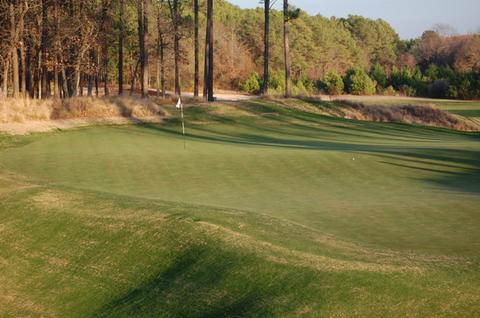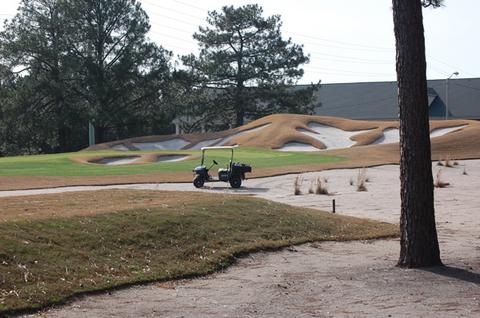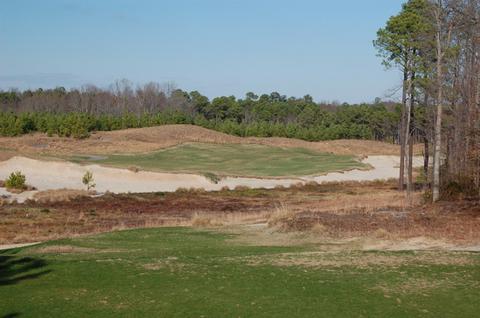
The tee shot at Tobbaco Road's 10th hole is best played down the left side for the best approach to the green.
Tobacco Road's locker room, just a bathroom really, includes a dozen lockers, all bearing nameplates. One is dedicated to Mike Strantz, who designed Tobacco Road and a handful of other courses and who tragically died of cancer at the age of 50 in 2005. The yardage book for the course includes a photo of Strantz, whose longish hair, walrus mustache and mischievous smile betray a certain élan and mischievousness that are on full display at Tobacco Road. The portfolio of work he left behind may not be large, but every course is distinctive and, especially for masochists, fun to play.
I featured the first nine holes at Tobacco Road in previous days. Here is a blow-by-blow rundown of the back nine at a course every golfer should play at least twice in their lives - once for the sheer experience and a second time to try to throw up a decent score. It can be done.
Certainly by the 10th tee, you should at least be used to the surprises and penalties Tobacco Road presents. Nowhere is the age-old advice about "fairways and greens" more appropriate or rewarding than at this unusual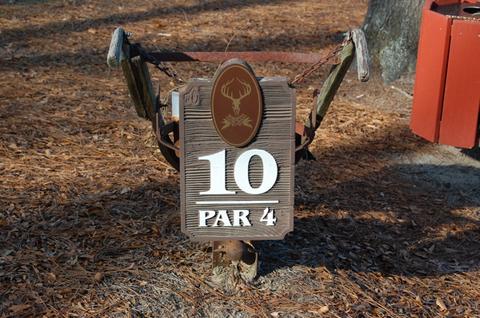 course. The 10th is a long par 4 with a dogleg right. A drive down the left side is necessary to have the best angle at the green with a long iron or fairway wood. If you are going to miss the green, it is best to leave your shot short and left to a generous mown area from which you can chip to the kidney shaped green. The green wraps around one of the smallest but most treacherous bunkers on the course. Miss just right of the green and you are in one of those ubiquitous wastelands with scrub bushes and acres of footprints. (Note: Local rules define all bunkers on the course as "waste" and permit smoothing of footprints and dropping your ball without penalty.)
course. The 10th is a long par 4 with a dogleg right. A drive down the left side is necessary to have the best angle at the green with a long iron or fairway wood. If you are going to miss the green, it is best to leave your shot short and left to a generous mown area from which you can chip to the kidney shaped green. The green wraps around one of the smallest but most treacherous bunkers on the course. Miss just right of the green and you are in one of those ubiquitous wastelands with scrub bushes and acres of footprints. (Note: Local rules define all bunkers on the course as "waste" and permit smoothing of footprints and dropping your ball without penalty.)
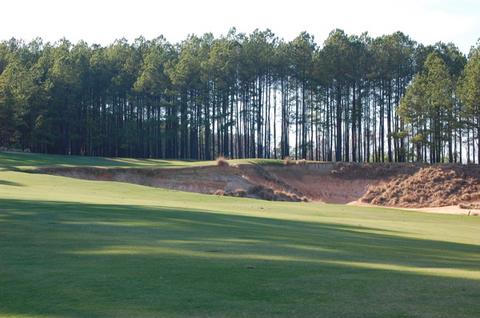
Far left is best for the approach to the elevated 11th green. Otherwise the approach is all carry.
The 11th shines as a great risk/reward par 5, the huge landing area off the tee begging for a drive about 250 yards to the right edge of the fairway, near the waste area, for a potential go at the green. That first challenge accomplished, the approach shot is about 200 yards over a wide expanse of waste and scrub to an elevated green. Land short of the narrow green and up and down will be nigh impossible. The same is true of a play from the deep bunker just over the green. The safe play on your second shot is a long iron to the elbow of the fairway before it turns back more than 90 degrees toward the green, a sand wedge away.
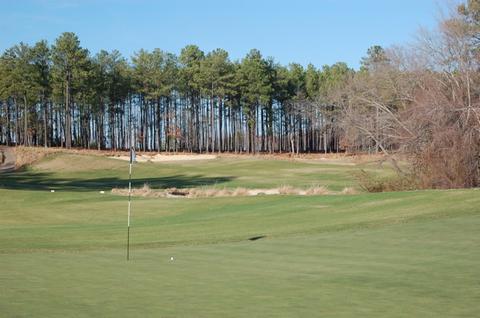
Although long, the par 4 12th hole is one of the more reasonable birdie opportunities at Tobacco Road.
The 12th, a 412-yard par 4, presents a quandary from the tee. Drive the ball more than 220 yards and the fairway narrows to virtually nothing. The wiser approach is to hit the ball about 210 or so for a long iron to one of the more receptive - i.e. least bunkered - greens on the course.
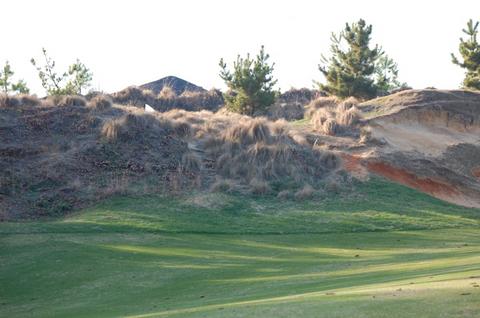
It takes a pegboard marker (inset) to have a clue where the pin is on the blind 13th green.
The double dogleg par 5 13th is vintage Strantz and the essence of Tobacco Road. The landing area off the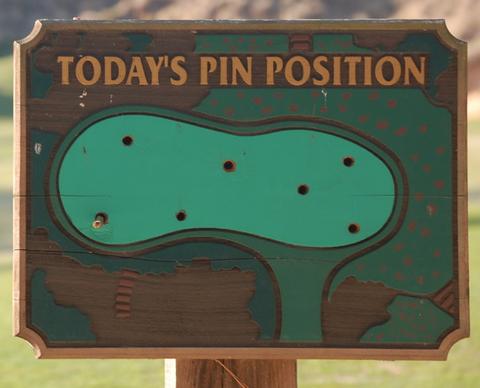 tee is generous as long as you don't try for too much length down the right, where a roll into a waste bunker could make it impossible to get your ball in position for an approach to the green. The
second shot should be approached without greed, a long iron to about 100 yards from the green. Ultimately, though, the 13th is all about the final approach to a green so hidden from fairway view that a pegboard near the second landing area indicates the day's precise pin position (see inset photo). The green is a mere 16 yards deep and a giant 47 yards wide, its only saving grace a bank behind and a little room just off the green way left. It is the toughest hole on the back nine.
tee is generous as long as you don't try for too much length down the right, where a roll into a waste bunker could make it impossible to get your ball in position for an approach to the green. The
second shot should be approached without greed, a long iron to about 100 yards from the green. Ultimately, though, the 13th is all about the final approach to a green so hidden from fairway view that a pegboard near the second landing area indicates the day's precise pin position (see inset photo). The green is a mere 16 yards deep and a giant 47 yards wide, its only saving grace a bank behind and a little room just off the green way left. It is the toughest hole on the back nine.
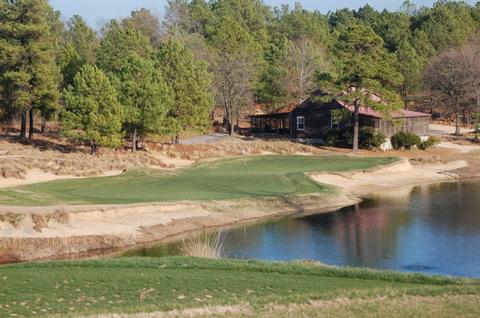
Our stroke of luck of the day was to find the pin in the center of the 14th green, the most accessible position on the multi-tiered surface.
We lucked out with the pin position on #14, a 158-yard carry over water to a 45-yard deep hourglass-shaped green surrounded by sand. The pin was dead center just below a dramatic rise to the back tier, but a 10 mph wind made club choice even more difficult. The water only comes into play if you are a club short or well right; a three-putt comes into play if you are putting from one tier to another.
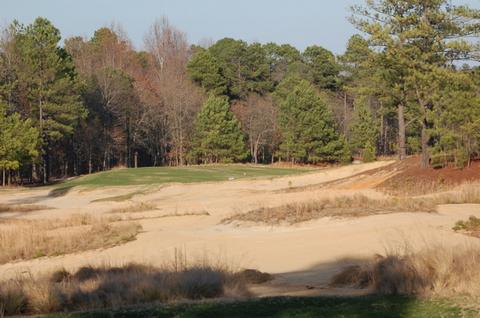
If you can work your ball left to right off the 15th tee, you will have the best look at the 15th green.
The 358-yard 15th demands a close look at the yardage book. From the tee, there doesn't appear to be much landing area, but it is actually quite generous if you don't hit your drive too long or too straight. How often do you hear that about a par 4? But Strantz splits the fairway with a waste area that is more gnarly bushes and grasses than sand; at 240 yards out, it can be reached from the tee. A fairway metal to the right and just short of the waste area provides the best angle to a green shaped like a whale with a huge tail at its front, just a few yards beyond the middle-fairway waste area. A long drive down the left leaves a short approach but to a narrow stretch of green surrounded by waste areas.
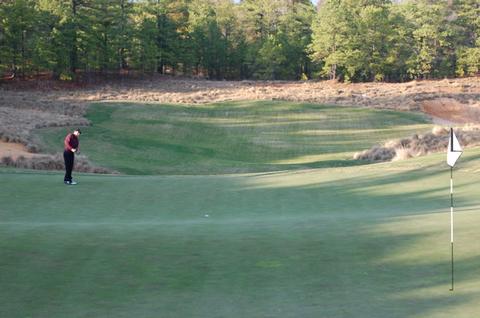
After a well-placed drive over the quarry (on the right), a short approach to a back pin leaves a tricky long putt up a steep slope.
Ahh, the 16th, an even shorter par 4 at just 321 yards but one that demands essentially the equivalent of two approaches to par 3s. It is tough to reconcile a 9 iron off the tee on a par 4 but, incredible as it may seem, that could save you from disaster on this devilish hole. Just a 125 yard shot down the left side leaves a 135-yard approach to a large, round, roller coaster green with a large false front. Otherwise, your play from the tee is a shot of between 170 and 210 yards over a quarry, the benefit being an approach of less than 100 yards, the detriment being that if you are short or long on your tee ball, the next shot may be unplayable from the quarry or a sandy wasteland.

At the 17th, the pin on the day we played was at the narrowest part of the widest green I have every played.
The final par 3 on the course sports the widest green I have ever played, more than 50 yards from one end to the other. Its depth to width ratio and amoebic shape is such that even if you hit the green, you might not be able to putt to the hole. It is possible to leave yourself a 120-foot putt; a shot just short and in the waste bunker could very well be a better alternative.
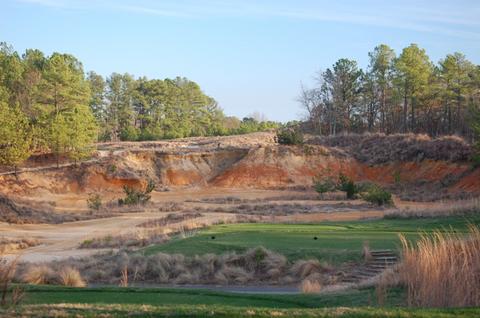
You push exhaustion aside on the teebox at the finishing hole. It is a fitting last drive on a day of intimidation off most tee boxes.
Finally the trek at Tobacco Road ends very much in the way it began as you face an incomprehensible looking tee shot. Where is the fairway, you wonder, even after consulting the yardage book? This is the most menacing drive of the day, a 200-yard carry over a sheer red clay cliff before a long iron to the green. Yes, a little finger of fairway stretches back toward the cliff, but you have about as much chance of stopping your ball on it as you do on the green at the 17th at Sawgrass (and with as much trouble surrounding it!). Grip and rip a drive and be happy anywhere on the short grass, although the right side of the fairway provides the only look at the green (top photo below). As if to add one last insult to a round of injuries, the greens keeper placed the final pin on the crest of a hill at the left rear of the green (see bottom photo). The only reasonable putt was from the right and below the hole, all others breaking wildly and fast.
I'll have some final wrap-up comments on Tobacco Road in the next day or two.
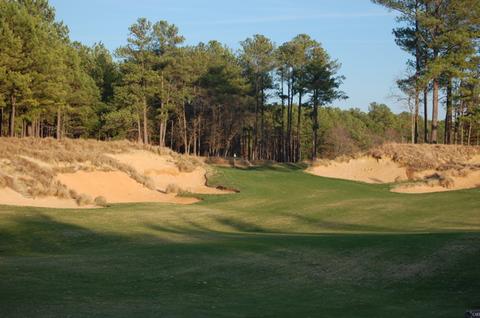
Consider yourself fortunate if you hit the fairway on the 18th, doubly so if you are on the right side of the fairway (above) so you are not flying blind on your approach. Consider it unlucky if the greenskeeper has awakened on the wrong side of the bed and placed the pin on a ridge (below).
